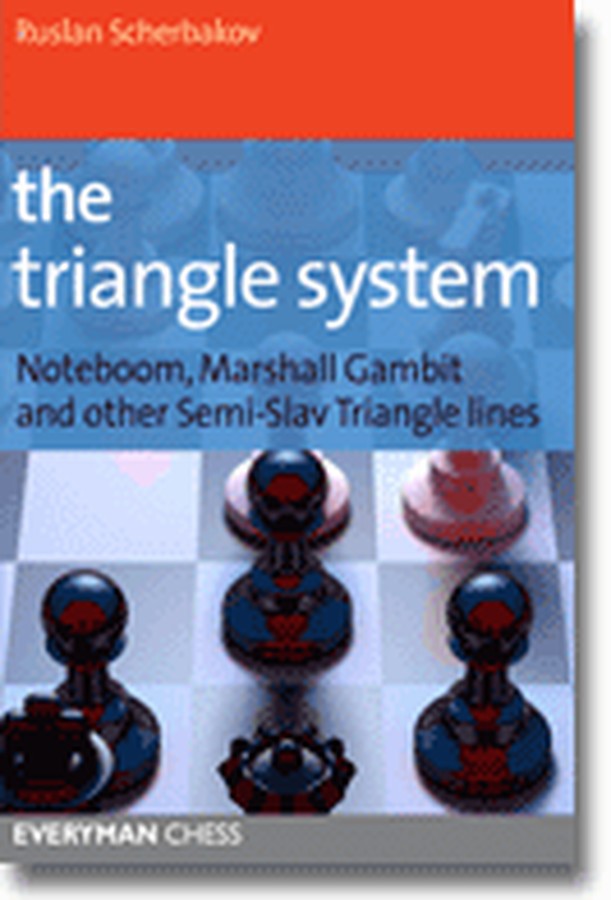| Nivå | C-D |
| Utgivelsesdato | Mars 2012 |
| Forfatter | |
| Pris | 250 NOK |
The Triangle System
Noteboom, Marshall Gambit and other Semi-Slav Triangle linesEn første stor spesialbok om systemene i dronninggambit der svart åpner med bonde-triangelet på c6, d5 og e6. Scherbakov hadde dette som en spesialitet allerede på 90-tallet. Basisvåpenet er Noteboom-systemet 1 d4 d5 2 c4 e6 3 Sc3 c6 4 Sf3 dxc4 med hårreisende ubalanse.
Forfatteren beskriver disse systemenes enkle og brutale grunnstrategi, kort fortalt: Å vente med å utvikle springeren til f6, i stedet først snappe bonden på c4 og dekke den med b7-b5 fulgt av utvikling av offiserene på dronningfløyene.
Hvis hvit ikke "kan teorien i Noteboom", kan han eller hun avvike ved for eksempel å holde c-bonden med trekk som 3 Sf3 c6 4 Sbd2, 4 Dc2, 4 Db3, eller et avbytte cxd5. I disse tilfellene endres spillets karakter, men samtidig blir svarts oppgaver antagelig objektivt enklere. Alle rimelige avvik drøftes i denne boka på 448 sider.
Forfatterens innledning
A first attempt to write this book was made in the late 1990s, when the Slav “Triangle” – or the “Wineglass”, as Maxim Sorokin described the black pawn structure – used to be my main weapon against 1 d4. However, after almost finishing the Noteboom and a good part of the Marshall, I was unable to complete the issue – family cares, growing kids and, at the same time, intensive coaching work forced me not only to put a few hundred pages on the shelf but almost to forget about playing chess tournaments! Meanwhile, working with players of different levels and styles distracted me from the Triangle itself. During the last decade many other opening systems occurred in my practice, so when I got a chance to resume this work at the end of 2010 everything had to be reviewed from the beginning. Yet, it was actually nice, as it brought some pleasant memories back to me...
Frankly speaking, I’ve always been a bit superficial in my approach to chess, digging wider – in contrast to Maxim, who always dug deeper. Writing this book in memory of my best friend, I tried hard to be as accurate and systematic as him, coming up in advance with answers to many possible questions which may occur to attentive readers. Perhaps it made the book rather heavy, but modern chess has become very concrete and requires thorough preparation in all parts of the game, starting from the opening. Actually, when it came to the final stage of writing I cut many variations from the book; but if the material is still a bit too complicated for lower-level players, I would offer a simple piece of advice: at first look through the main lines, given in bold, and only refer to the sidelines later, whenever you feel it is required.
This book gives a complete and well-organized repertoire for Black, based on the Slav Triangle. However, I didn’t avoid any problems Black may face, so it should be also helpful for White players in their search for a way to counter the Triangle. I tried to remain as objective as possible, so don’t be surprised to see an assessment like “White keeps a slight edge” at the end of some lines. In fact this is true for almost every normal opening system, so why should the Triangle be an exception?!The strategic ideas behind Black’s approach are rather simple and can be described in a few words: grab the pawn on c4, protect it by ...b7-b5, and prepare an advance ...c6-c5 to get the light-squared bishop into play and undouble the c-pawns. As a rule, if Black succeeds with this plan, he obtains a tangible advantage, though of course there will be many obstacles in the way. Actually, it may look like Black is ignoring some basic principles of opening play, such as quick development, safety, fighting for the centre. He should certainly keep those in mind, but at the same time he wants to get some benefit on the queenside.
Isn’t it too ambitious for the beginning of the game?! Doesn’t it look like Black is trying to kill two birds with one stone? Perhaps, but there will be more stones in his bag! Besides, Black isn’t playing this way against 1 e4 – it’s a closed opening after all and White can’t develop an initiative so quickly. Perhaps Black’s approach might be called an exception, but it has been successful so many times in practice it should already become the rule! In some lines Black has more than one possible way to play and, in spite of my own preference and simply to give a choice, I have covered most reasonable options – sometimes even those not quite satisfactory from Black’s point of view, if there were some interesting or typical ideas which would be useful in other lines.
With the help of this book, which gives a complete picture of the “Slav Triangle” and many related systems, you may comfortably build your own repertoire with Black, adjusting it to your own style, level or your goals in chess. I’ve also attempted to provide as much explanation as possible since, as Eugene Znosko-Borovsky taught more than 75 years back, understanding typical plans and ideas, thematic manoeuvres and common tactics is more important than learning numerous variations by heart. As often happens in the latter case, a player is unable to refute a dubious move simply because he didn’t see it in the book. On the other hand, since the Triangle can lead to rather unusual positions, it might be difficult – and in many cases not quite correct – to apply general principles, so the more concrete details aren’t superfluous either. Modern chess hasn’t only become a rather tough kind of sport, it’s also becoming more and more scientific and so requires more and more precise knowledge...
Among those players who have regularly caused headaches for White and advanced the theory of the Slav Triangle, I would mention (in the order they came to mind): Maxim Sorokin, Alexander Galkin, Pavel Tregubov, Michal Krasenkow, Andrei Kharlov, Marek Matlak, Glenn Flear, Evgeny Sveshnikov, Alexander Moroz, Igor Novikov, Oleg Korneev, Marinus Kuijf, Markus Stangl, Josef Klinger, and Mark Van der Werf. Younger generations would be represented by Yuri Shulman, Dusko Pavasovic, Jakov Geller, Dmitry Frolyanov, Artyom Timofeev, Vladimir Malakhov, Sergei Zhigalko, and Niclas Huschenbeth. Almost all top players, including the World Champions, have used the Triangle from time to time, but two of them, Alexei Shirov and Alexander Grischuk, deserve special praise for their contribution to the Noteboom and the Triangle Stonewall. As you may have noticed, a huge majority of the Triangle advocates mentioned here are Russian-speaking players, so I apologize in advance to those, especially from other parts of the world, who are somehow omitted from the list.
I would also like to thank some people personally, without whom this book would hardly have been written: Alexander Filipenko and Evgeny Gleizerov, who taught all of us to play the Meran and Stonewall at Alexander Panchenko’s chess school in the 1980s, and of course “Pancha” himself, who was my coach for many years (sadly, he’s no longer with us); Alex Volzhin, who partially shared my enthusiasm for the Noteboom in the 1990s; Kateryna Lahno, who encouraged me to resume and finally complete this work; John Emms, who guided me through the writing process and kindly accepted all delays; and very special thanks to my wife Tatiana, who took care of our kids and many other things while I was plunged into this work.
In conclusion I would like to encourage readers to get the most benefit from my first big work. Enjoy sailing in the often troubled waters of the Slav Triangle and let it become the “Bermuda Triangle” for your opponents!
| Innbundet? | Nei |
| Type | Bok |
| Språk | Engelsk |
| Antall sider | 448 |

